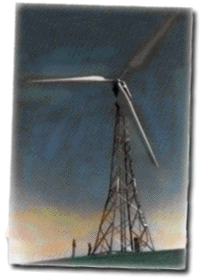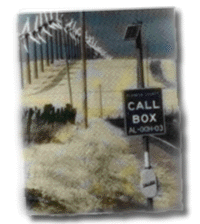

H
ello and welcome to the Science Learning Network. We are a collaborative of science centers, schools, and other partners working together to develop science education resources on the Internet. This part of the SLN is called the Inquiry Focus and is a regularly changing article that will feature exciting places, interesting people, and other topics related to exploration of scientific concepts. This month we're looking at Wind Farms and as our first issue, we're going to use it as an opportunity to explore the other parts of the SLN.
For starters, here's a short introduction to Wind Farms by science writer, Karen Mendelow
S
outheast of San Francisco, on the way out to California's Central
Valley, 7,500 windmills of all shapes and sizes dot the golden hills of the
Altamount Pass. As you drive past, you can see the windmills spinning and
swirling high above the freeway. Mounted both in rows and individually,
machines with propellers and egg-beater blades catch the wind, turning
round and round at different speeds. In the midst of all this activity, a
few windmills stand still, despite the breeze. Below the windmills, cows
graze on the hillside- the land is not only a wind farm, its also a pasture
land for local ranchers.
T
he wind that turns the windmills is a form of solar energy. The
sun warms the earth's atmosphere unevenly, causing the air to move and
swirl, creating wind. For hundreds of years, wind movement has been
converted to mechanical power to pump water and grind grain. This power
can also be used efficiently to turn turbines for electrical generation.
Wind power is rapidly becoming economically competitive with conventional
power sources, making it a bright prospect for the future.
E
ven in the windiest spot, the wind speed and direction are
constantly changing. For the last twenty years, researchers have
concentrated on developing a windmill that insures maximum electrical
output under varying wind conditions and on placing the windmill in the
best location to catch the most wind power.
E
ach windmill is also equipped with an anemometer to track wind
speed and a wind vane to track wind direction. The readings from these
instruments feed into a computer in each individual windmill to operate it
most efficiently.
T
he latest wind turbine- designed and developed by a consortium
that includes US Windpower, Electric Power Research Institute, Pacific Gas
and Electric, and Niagara Mohawk Power Corporation- is the 33M-VS, which
operates when the wind is blowing at speeds between 9 and 65 miles per
hour. It has an advanced aerodynamic rotor with a diameter of thirty-three
meters, a tower height of thirty meters, and an output of 400 kilowatts.
 W
ind Farms are an exciting point of departure for inquiry science learning because they appeal to learners of all ages, demonstrate many interesting scientific principles, are visually interesting, and open up into many related areas for inquiry including environmental studies, energy, solar power, economics, engineering, and more.
W
ind Farms are an exciting point of departure for inquiry science learning because they appeal to learners of all ages, demonstrate many interesting scientific principles, are visually interesting, and open up into many related areas for inquiry including environmental studies, energy, solar power, economics, engineering, and more.
Wind Farms: By Karen Mendelow
 D
uring the 1970's, when tax credits favored alternative energy
research, many models were developed and tested. Some designs operate only
at certain wind speeds. For instance, some turn only when the wind blows at
speeds between 15 and 35 miles per hour. If the wind is any faster or
slower, the windmill doesn't spin. (that's why visitors passing through
Altamont Pass sometimes notice that some windmills are standing still while
others are spinning furiously.)
D
uring the 1970's, when tax credits favored alternative energy
research, many models were developed and tested. Some designs operate only
at certain wind speeds. For instance, some turn only when the wind blows at
speeds between 15 and 35 miles per hour. If the wind is any faster or
slower, the windmill doesn't spin. (that's why visitors passing through
Altamont Pass sometimes notice that some windmills are standing still while
others are spinning furiously.)

